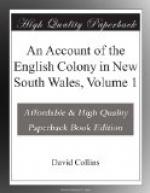[* 3353 Rhineland feet—a Rhineland foot being twelve inches and 5/12 English.]
The Cape is celebrated for producing in the highest perfection all the tropical and other fruits; but of the few that were in season during our stay we could not pronounce so favourably. The oranges and bananas in particular were not equal to those of Rio de Janeiro. The grape we could only taste from the bottle; that of Constantia, so much famed, has a very fine, rich, and pleasant flavour, and is an excellent cordial; but much of the wine that is sold under that name was never made of the grape of Constantia; for the vineyard is but small, and has credit for a much greater produce that it could possibly yield: this reminds us of those eminent masters in the art of painting, to whom more originals are ascribed than the labour of the longest life of man could produce.
Wines of their own growth formed a considerable article of traffic here; and the neatness, regularity, and extent of their wine-vaults, were extremely pleasing to the eye; but a stranger should not visit more than one of them in a day; for almost every cask has some peculiarity to recommend it, and its contents must be tasted.
We found the paper currency here very inconvenient, from its lightness; as more than one instance occurred among ourselves during our stay, of its being torn from our hands by the violence of the south-east wind, when we were about to make a payment in the street, or even at the door of a shop.
The meat of the Cape was excellent; the black cattle were large, very strong, and remarkable for the great space between their horns. It was not uncommon to see twelve, fourteen, or sixteen oxen yoked in pairs to a waggon, and galloping through the streets of the town, preceded by a Hottentot boy, who accompanied them on foot, conducting the foremost couple by a leathern thong, which caution they are compelled to observe by an order of government, some accidents having formerly happened from some of these large teams having been imprudently driven through the streets without any one to lead them; the lash of the charioteer (for the driver of such a team deserves a more honourable appellation than that of waggoner) had been sometimes heard, we were told, on board of ships in the bay.
The sheep are fat, well-flavoured, and remarkable for the weight and size of their tails. Wonders have been related of them by travellers; but travellers from this part of the world are privileged to exaggerate in their narrations, if they choose so to do; the truth however is, that their tails weigh from eight to sixteen pounds; some few perhaps may be heavier by a pound or two; but though the sheep itself will very well endure the voyage to Europe, yet its tall considerably decreases in size and weight during the passage.




